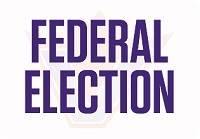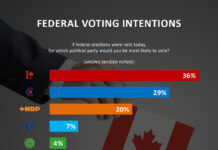We may well be waiting until the final vote tallies in B.C. to see who will win on Monday
THE 43rd federal election is lurching to the finish line and we still don’t know who the winner(s) will be.
The race is a statistical tie, with the Conservatives holding the narrowest of leads over the Liberals (32.5 per cent versus 31.0 per cent).
The rejuvenated NDP is now stalled at 17.6 points and the Greens having fallen back to 7.9 points.
The People’s Party is also fading and now sits at 3.6 per cent.
In Quebec, the Bloc Québécois have had a renaissance, but that too appears to have stalled and they have fallen out of a tie and are now 10 points behind the Liberals in Quebec at 24 points.

A number of forces make the outcome of the election less than clear. First, the regional patterns: the Conservatives enjoy huge leads in Alberta and Saskatchewan; however, this overconcentration of support is inefficient in terms of seat outcomes.
In particular, their deficit in Ontario (31 per cent versus 37 per cent for the Liberals) has major seat implications. The Ontario landscape may be complicated by a rising NDP, which now stands at 20 points in the province.
In Quebec, the Conservatives are not really in the fray at 14 points. British Columbia is a confused mess of four parties with the Greens fading somewhat in the final weeks of the campaign. All in all, however, the regional patterns favour the Liberals in terms of seat counts.
This picture would be much gloomier for the Conservative Party if it weren’t for their strong performance in the unusually large advance voter turnout where they have a 10-point advantage over the Liberals. Now, an important caveat is needed here: given the small sample sizes, we’re not entirely convinced that the 10-point lead is accurate; the Conservatives certainly have a lead, but the exact magnitude isn’t clear. The size of the lead shrank in later part of the polling period (which should not happen given that the advance polls closed before the polling period), so the results might be susceptible to measurement and sampling errors.
Nevertheless, the Conservatives have a large ‘out of the block’ lead with the advanced vote and turnout will therefore be critically important. The larger the turnout, the more the advance voting advantage is diminished. If the turnout resembles 2011, the Conservatives may well win. If it resembles 2015, they won’t.
Points of stability and potential flux
The Conservatives have little room to grow. The final movements in the campaign will most likely be the shifts across the boundaries of the Liberal and NDP constituencies, where the promiscuous progressive voters show ambivalence about which party to support. Indeed, we are registering very high levels of indecision, focused primarily among the centre-left portion of the spectrum. The final decisions of these voters will ultimately be linked to perception of the likely outcome of the election. It is odd for the Conservatives to be talking about a looming victory, as this may well increase both turnout and shifting back to the Liberals.
Bottom line
Right now, the outcome of these factors makes the outcome of the election unclear. If we were forced to make a conjecture, we would guess at a Liberal minority outcome at this stage but that is uncertain. There are many ridings where the Conservatives have a slim plurality but will now win because of Liberal-NDP contests. We may well be waiting until the final vote tallies in British Columbia to see who will win on Monday.
- EKOS Politics












